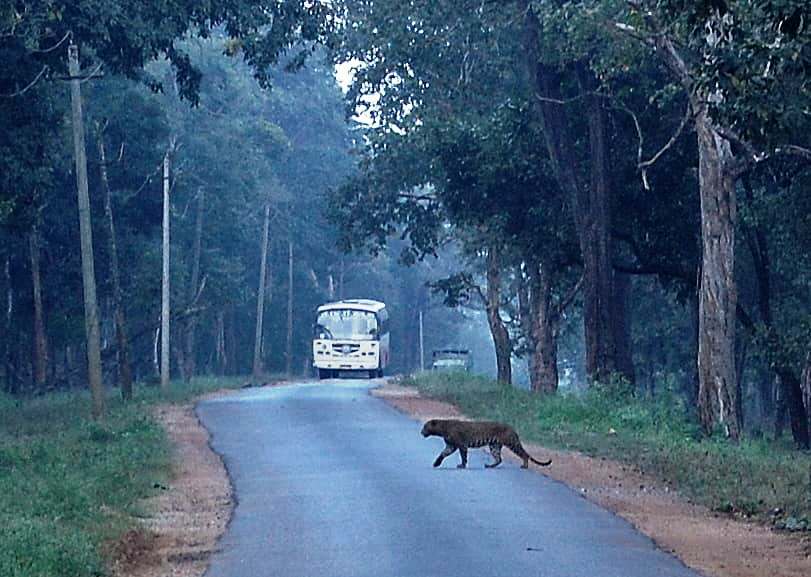If pictures can break our hearts, they can surely stir us into action. These days, a kind of pictures increasingly orbiting Indian cyberspace is of dead animals lying on the sides of roads or on railway tracks after being hit by vehicles. One species, whose pictures pop up almost every fortnight, is also arguably one of the worst hit by linear projects that are slicing up India’s forests at a rapid rate – the leopard.

A leopard crosses a highway in Southern India. Source: Conservation India.
A lactating leopard lying on her side, her cub in suckling position, both dead, with similar head injuries by a speeding vehicle – among all roadkill pictures, this is one of the most retweeted and commented upon. Such pictures rouse public emotions, stimulate minds to question short-sighted growth plans, and add a few numbers to the minority that cares about conserving wildlife and its ecosystems.
Even as new highways are being built in wildlife-rich areas and existing ones widened, the Wildlife Conservation Trust (WCT) is closely monitoring the impact of these linear intrusions on India’s wildlife. An important endeavour in this direction is Roadkills – an Android app developed by WCT. Born out of the idea of converting growing public awareness and concern into conservation action, Roadkills is a citizen science project that engages concerned citizens in collecting data on mortality of wild animals on roads, railway lines and irrigation canals across the country. The data is collected in the form of geotagged photographs which users of the app click when they come across roadkills.
Roadkill photos shared on social media continue to elicit reactions like, “Why can’t there be speed limits on roads that go through forest areas?”, “Blatant disregard for wildlife…”, and “Overpasses and underpasses would cost a fraction of the cost of a bullet train”. Now, they are also giving distraught citizens a chance to become a part of a conservation movement. The photos uploaded to the Roadkills app are adding to an ever-expanding database of information on sensitive locations where wildlife crossing structures are needed, as well as the multitude of species that are dying on roads and railway lines.
As the government fast-tracks development of new highways and widening of existing ones, instances of roadkills are also on the rise. While the deaths of charismatic mammals like tigers and elephants are making headlines and drawing attention to the problem, countless equally important and endangered species of frogs, snakes, birds and small mammals are dying every day, unrecorded.
With growing public concern and increased participation in the citizen science project, the onus will be on the government to prioritise the conservation of wildlife by avoiding wildlife-rich areas while planning linear infrastructure projects, or making sufficient mitigation measures a part of the projects during the planning stages.
Towards the end of 2017, the Indian government approved the biggest highway construction plan ever for the country – to develop 83,677 kms of highways at a cost of Rs 6.92 lakh crores by 2022. In June 2019, the Road Transport and Highways Minister Nitin Gadkari announced plans to infuse Rs 15 lakh crores in building highways. These economic corridors should not be built at the cost of ecological connectivity. Accepting the deaths of our endangered tigers, toads, elephants and pangolins as collateral damage in our race for economic connectivity will be our biggest folly.
This article was first published in The Tilak Chronicle in August 2019.
——————————————————————————————————————————————————————
About the Author: Rizwan Mithawala is a Conservation Writer with the Wildlife Conservation Trust and a Fellow of the International League of Conservation Writers. He has previously worked as an environment/conservation journalist with a national newspaper.
——————————————————————————————————————————————————————
Disclaimer: The author is associated with Wildlife Conservation Trust. The views and opinions expressed in the article are his own and do not necessarily reflect the views and opinions of Wildlife Conservation Trust.
Related Links
- Conservation Strategy
- Averting Extinction – One Blood Sample at a Time
- Illegal Wildlife Trade: The Need to Look Within
- 9 Steps to an Environment Friendly Lifestyle
- Forensics in Wildlife Crime Investigation
- Thought Leadership
- Fox lights to keep wild animals at bay in Brahmapuri forest division
